| MAY 2022 |
|
5 shows in T˘ky˘ (Kabukiza, National Theatre, Hitotsubashi Hall), 1 in Ky˘to (Minamiza), 1 in Nagoya (Misonoza), 1 in Ky˘tango (Tango Bunka Kaikan), 1 in Saitama (Rai BoC Hall) and 1 in Ena (Ena Culture Center)!
|
| Kabukiza (T˘ky˘) |  |
| Dates | 2 ~ 27 May 2022 Dankikusai Gogatsu ďkabuki Dankikusai May Grand Kabuki |
| 1st program |
Gion Sairei Shink˘ki (Kinkakuji) Ayame Yukata |
| 2nd program | |
| 3rd program |
Benten Musume Meo no Shiranami
|
| Casting |
Living National Treasure Onoe Kikugor˘, Living National Treasure Nakamura T˘z˘, Nakamura Baigyoku, Nakamura Kaishun, Nakamura Fukusuke, Nakamura Tokiz˘, Onoe Kikunosuke, Nakamura Jakuemon, Ichikawa Ebiz˘, Kataoka Ainosuke, Kataoka Takatar˘, Onoe Sh˘roku, Nakamura Kinnosuke, Ichikawa Sadanji, Ichikawa Udanji, Band˘ Hikosabur˘, ďtani Tomoemon, Nakamura Kotar˘, Nakamura Baishi, Nakamura Hayato, Band˘ Minosuke, Onoe Ukon, Nakamura Matagor˘, Kawarasaki Gonjűr˘, Kataoka Ichiz˘, Band˘ Kamez˘, Ichikawa Sai'nyű, Ichimura Kakitsu, Ichikawa Omez˘, Kamimura Kichiya, Ichikawa Kudanji, Nakamura Kangyoku, Nakamura Kash˘, Nakamura Yonekichi, Nakamura Hashinosuke, Nakamura Mantar˘, Nakamura Tanenosuke, Band˘ Shingo, Nakamura Takanosuke, ďtani Hiromatsu, Kataoka Sennosuke, Nakamura Kichinoj˘, Ichimura Kitsutar˘, Nakamura Fukunosuke, Nakamura Utanosuke, Onoe Ushinosuke, Onoe Sakon, Ichikawa Otora, Nakamura Tamatar˘, Band˘ Kamesabur˘ |
| Comments |
The great yearly Dankiku festival is back at the Kabukiza! No Dankiku festival in May 2020 and May 2021. This important festival for the Naritaya and Otowaya guilds commemorates 2 great stars of the Meiji era: Dan = Ichikawa Danjűr˘ IX and Kiku = Onoe Kikugor˘ V.
|
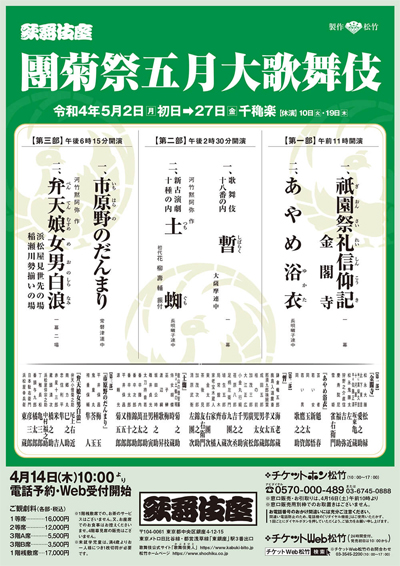 |
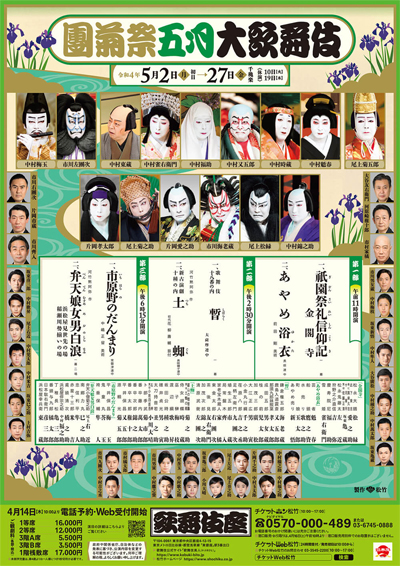 |
| National Theatre (T˘ky˘) |
| Dates | 14 ~ 23 May 2022 Zenshinza Gogatsu K˘en Zenshinza May Performances |
| Program | |
| Casting | |
| Comments |
Revival at the National Theatre by the Zenshinza of Tsuruya Nanboku IV's masterpiece "Kakitsubata Iro mo Edozome". It is staged to commemorate the 32nd anniversary (33rd memorial services) of the passing away of late Kawarasaki Kunitar˘ V.
|
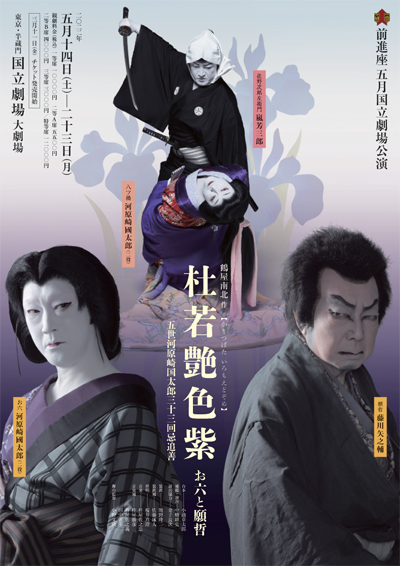 |
| Tango Bunka Kaikan (Ky˘tango) | |
| Dates | 3 ~ 4 May 2022 Band˘ Tamasabur˘ Ky˘tango Tokubetsu Buy˘ K˘en Band˘ Tamasabur˘ Ky˘tango Special Dance Performances |
| Program |
Oimatsu |
| Casting |
Living National Treasure Band˘ Tamasabur˘ |
| Comments |
A special Buy˘ program starring the amazing Living National Treasure onnagata Band˘ Tamasabur˘ in Ky˘tango at the Tango Bunka Kaikan (Tango Culture Center).
|
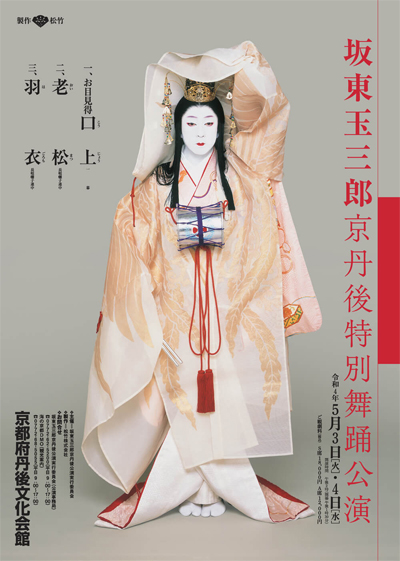 |
|
|
| Dates | 12 ~ 18 May 2022 Kabuki Kansh˘ Ky˘shitsu Kabuki Appreciation Class |
| Program |
Kabuki no Iroha |
| Casting |
Kamimura Kichitar˘, Kataoka Senju, Shigeyama Ippei |
| Comments |
Young actors performing in Ky˘to at the Minamiza. The same program is staged twice a day, at 11 and at 15:30 with a different casting.
|
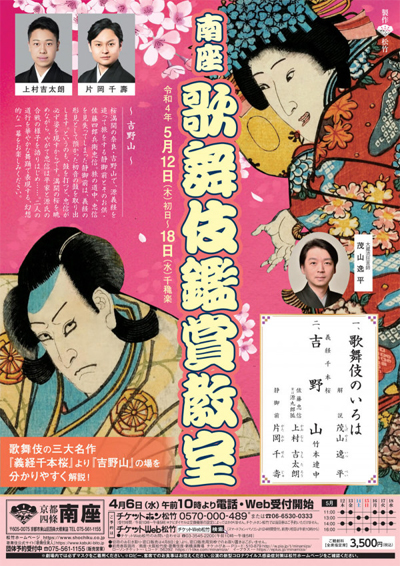 |
| Misonoza (Nagoya) |  |
| Dates | 27 ~ 29 May 2022 Band˘ Tamasabur˘ Tokubetsu Buy˘ K˘en Band˘ Tamasabur˘ Special Dance Performances |
| Program |
Keisei |
| Casting |
Living National Treasure Band˘ Tamasabur˘, Nakamura Ganjir˘ |
| Comments |
A special Buy˘ program starring the amazing Living National Treasure onnagata Band˘ Tamasabur˘ in Nagoya at the Misonoza.
|
 |
| Rai BoC Hall (Saitama) | |
| Dates | 10 May 2022 Kokera Otoshi Kabuki K˘en Opening Ceremony Kabuki Performances |
| Program | |
| Casting | |
| Comments |
Kokera Otoshi Kabuki program for the Rai BoC Hall (ďmiya Civic Hall) in Saitama. The name RaiBoC comes from the words Railway, Bonsai and Cartoon.
|
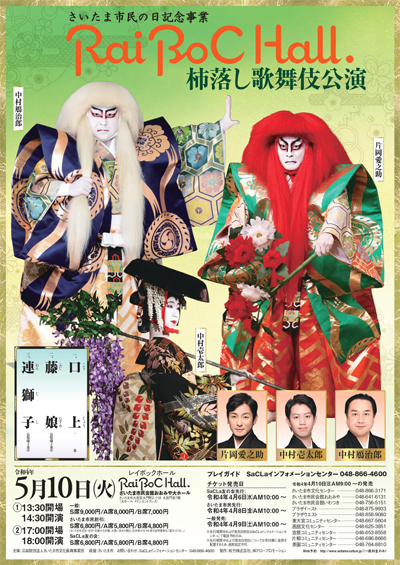 |
| Hitotsubashi Hall (T˘ky˘) | |
| Dates | 23 ~ 24 May 2022 Futari o Miru Kai |
| Program |
Zadankai |
| Casting | |
| Comments |
1st edition of the Futari o Miru Kai, a gala program which stars Ichikawa Ennosuke and Nakamura Kazutar˘, in T˘ky˘ at the Hitotsubashi Hall of the Japan Education Center.
|
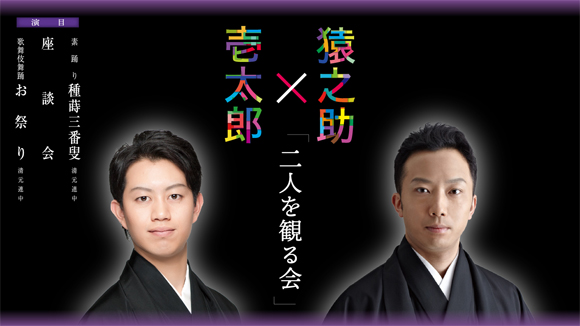 |
| Ena Culture Center (Ena) | |
| Dates | 29 May 2022 Kabuki Buy˘ K˘en Kabuki Dance Performances |
| Program |
Kabuki no Torisetsu |
| Casting |
Nakamura Ich˘ |
| Comments |
A special Buy˘ program starring Nakamura Ich˘ in Ena (Gifu Prefecture) at the Ena Culture Center. |
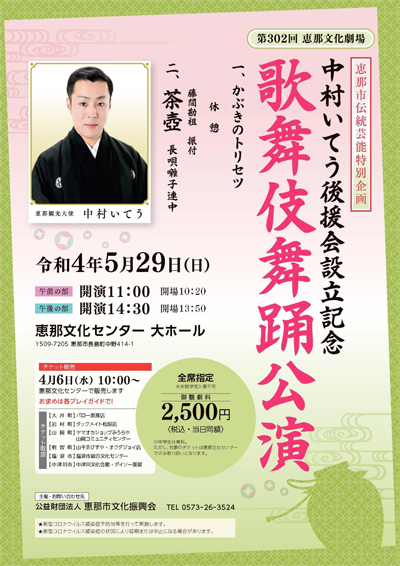 |
|
|
| Contact | Main | Top | Updates | Actors | Plays | Playwrights | Programs | Links | FAQ | Glossary | Chronology | Illustrations | Prints | Characters | Derivatives | Theaters | Coming soon | News |